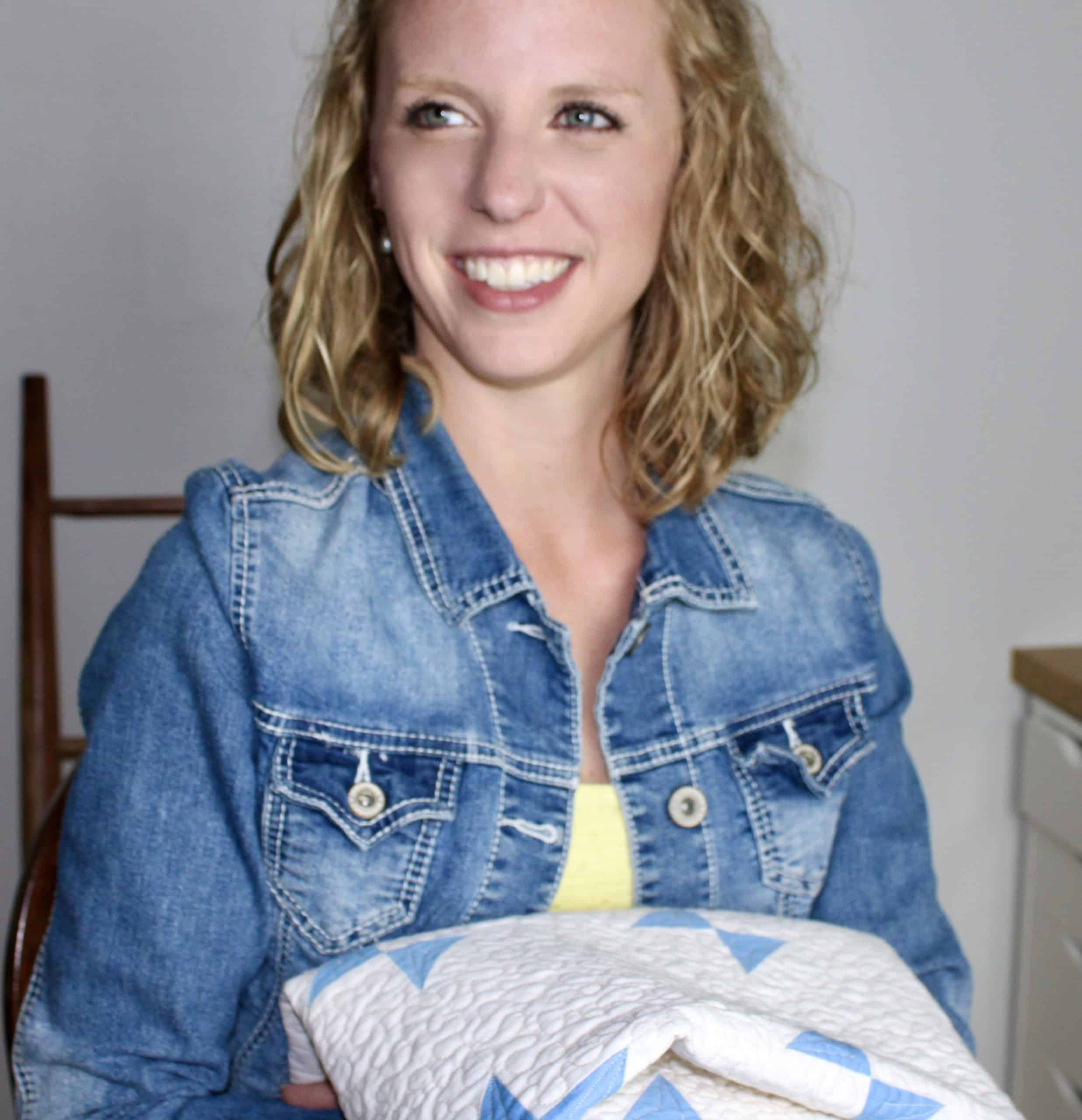You’ve spent god knows how many hours working on this quilt.
Stressing about every single aspect.
Are your points lining up? What about the seams?
Are your colors clashing? Or complementing?
Not to mention likely spent well over $100 just on the materials!
You put all this effort into perfecting this quilt and are super proud to gift it to a family member for a special occasion.
Do you really want them throwing that quilt in the weekly family laundry?

Or maybe you were the one who was gifted a quilt by your favorite family member and you want to learn how to wash a quilt so it lasts as long as possible.
No matter who you are in the scenario, I think we can all agree, quilts are made to be used!
And when things are used, they are likely to have accidents, get spills, and if you are like me, dog drool, and coffee stains…
If you never use a quilt, it will never get these stains, but if you never use the quilt, then you have an heirloom that is worse than a set of crystal candle sticks.
At least the candle sticks are left out to be seen as opposed to packed away somewhere in a linen closet where it won’t “accidentally” be used.
As long as you learn how to wash a quilt the right way, there is no reason why you or your loved ones shouldn’t be able to use that quilt on a daily basis.
So today we are talking about the 7 steps for how to wash a quilt and care for it to ensure its longevity and heirloominess.
Wash on gentle setting

When a quilt gets wet, the batting will quickly soak up water like a sponge and hold on to it until it slowly dries making a wet quilt VERY heavy in comparison to its dry form.
What can happen when a quilt is tossed and turned in a washing machine is that weight can put stress on the tiny stitches holding the patchwork together and can cause popping of stitches, opening seams, and putting holes in your quilt.
Washing on the gentle cycle will put less stress on the wet quilt and keep the stitches in tact.
So while you certainly don’t need to dry clean it, be sure to use the gentle cycle to avoid over wringing the quilt and popping those stitches by accident.
Wash in cold water
Some of the most popular quilts out there are two color quilts, where one of those colors typically happens to be white, or light in general.
I don’t know about you guys, but I’ve definitely had more than enough loads of laundry turn pink in the past.
I have absolutely no desire to see it happen to a handmade quilt.
Washing with cold water will help prevent colors from bleeding into each other causing staining and discoloring.
And always always, add a color catcher into the wash just incase colors still happen to bleed.

If you’ve never used these little gems, you’d be surprised how awesome they work. They look like dryer sheets, but you toss them in the washer with the quilt. The sheets will absorb any free dye in the water before the dyes have the opportunity to absorb into the light fabrics.
Keeping your quilt colored where it’s supposed to, and white where it’s not.
I had difficulty finding them at first, apparently my target doesn’t carry them, so if you can’t find them either they are definitely a need-to-have when washing quilts so check out the color catchers on Amazon.
These things are like gold when it comes to making sure your quilt washing adventure goes over smoothly!
Consider a laundromat

Remember when we were talking about how quilts act like a sponge when they see water?
Depending on how big the quilt is that you are washing, that heavy quilt may actually be too heavy for your washer.
If you have an abnormally bulky quilt or are attempting to wash a queen/king size bed quilt, consider bringing it to a laundromat instead of washing it at home.
Related:
Standard Quilt Sizes
The industrial quality of a laundromat washer is going to be way more suitable for such a heavy quilt when wet.
It would NOT be fun to get halfway through the wash cycle just to find out that your home machine simply can’t handle the weight and aborts the wash before the spin cycle.
Sopping wet and full of soap you’ll likely be stuck bringing it to a laundromat to finish the job. Soaking your car in the process.
The laundromat industrial grade washers are going to be way more equipped to wash that heavy of a load without fail – or swearing on your part.
Dry on low or no heat

Most people are familiar with the concept that cotton shrinks in the dryer.
Quilts are unfortunately not immune to the phenomenon.
Machine drying is a great way to get your quilt dried quickly, however, high temperatures of the dying cycle have the potential to shrink your quilt.
So don’t be afraid to put that quilt in the dryer, just be sure that it has a little heat applied as possible.
And when you use the dryer, be sure to only get it started with the dryer and take it out to air dry. Tumbling wet in the dryer also has the potential to pop stitches from the quilt’s wet weight so getting it started in the dryer is perfectly fine, but leaving it out to air dry is even better.
Lay flat to air dry
When you air dry it, be sure to make sure it lays flat.
Whether you decide to air dry the entire quilt, or you do most of it in the dryer and finish up with air drying, lay that thing flat!
Have you ever air dried a shirt or jeans on a drying rack and when you pull it off it basically dried in a “U” shape because it was draped over a rod?
The same thing will happen to your quilt putting wear on the fibers and batting where that crease point is.
Additionally, because of the additional weight of the water in the quilt, by hanging it from a single stress point, you are adding significantly more stress to the seams that cross that bar that you are hanging it from.
Over time those threads will wear thinner and thinner until they break all together putting holes in your seams.
It is very popular to air dry quilts on the grass on sunny days where it can lay flat and the wind can help dry it faster, however any flat place in the house will do as well!
Fold on the bias

Imagine taking a bed sheet out of your linen closet.
You unfold it to make the bed, shake it out and it is naturally covered in wrinkles and creases from being in storage.
The same thing happens to your quilts.
When you match up your corners and you fold the quilt in half, and then half again, just like a bed sheet, you are folding the quilt along the grain of the fabric.
And when you fold a quilt along the fabric grain, it is way more likely to develop creases that will put wear on the fibers at the crease point. This will (over time) cause deterioration of the fibers at those points.
So to avoid this, fold along the bias!
What does that mean…
For the same reason we have to be carefully when quilting with fabrics cut on the bias, here it helps us!
The flexibility and stretchiness on the bias makes it much more willing to bounce back to shape instead of holding on to creases.
So to do this, lay your quilt out.
Instead of folding in half and then half again, fold your corners in first so they make right angles with the other sides of the quilt.
Now you can fold in half and half again, following the new lines.
Folding the corners in puts your crease lines at a diagonal to the grain of the quilt instead of directly following the grain.
By using this folding method, not only do you have a larger comfier looking quilt, but you won’t get those ugly crease lines as quickly.
And to almost totally avoid crease lines?
Refold your quilt regularly

Taking the quilt out of storage, laying it out (preferrably using it), and airing it out will help keep the quilt comfy and soft as opposed to the generally stiff nature it has just after it’s made.
Refolding your quilt regularly and in slightly different ways will go miles to avoid crease marks from the folding of your quilt.
Creases put unnecessary stress and damage to the quilt weakening the batting and fabric in those areas.
By refolding regularly (every few months or so) you’ll help extend the longevity of your quilt significantly.
But don’t worry

If you didn’t know how to wash a quilt before today and have made a few of these mistakes, it’s not the end of the world.
While these are certainly best practices and some of the best ways to keep your quilt around for generations, you quilt is not going to disintegrate if you put it in the wash on high temp.
Or dry it entirely in the dryer.
It will still be around for a long time, the colors just may not be quite as vibrant over time, or it might shrink a little in size, but all in all 100% still a perfectly useable quilt.
But following these steps will certainly help keep your quilt around for generations to come.
And keep it looking just as beautiful then as it does now.
So next time you need to teach a family member how to wash a quilt, keep these steps in mind and you’ll keep that quilt beautiful for as long as possible!
If you liked this post be sure to follow me on pinterest below for all my latest and greatest articles!









0 Comments